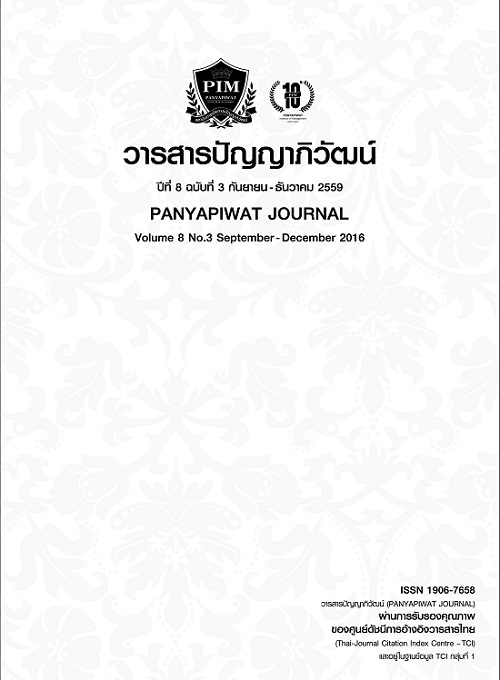ผลการสังเคราะห์กรอบแนวคิดของโมเดลสิ่งแวดล้อมทางการเรียนรู้ที่ส่งเสริมการประมวลสารสนเทศ โดยการบูรณาการระหว่างศาสตร์การสอนและประสาทวิทยาศาสตร์
Main Article Content
Abstract
การศึกษาครั้งนี้มีวัตถุประสงค์เพื่อสังเคราะห์กรอบแนวคิดของโมเดลสิ่งแวดล้อมทางการเรียนรู้ที่ส่งเสริมการประมวลสารสนเทศ โดยการบูรณาการระหว่างศาสตร์การสอน และประสาทวิทยาศาสตร์ กลุ่มเป้าหมายที่ใช้ในการศึกษา ได้แก่ นักเรียนชั้นประถมศึกษาปีที่ 5 โรงเรียนเทศบาลน้ำพองภูริพัฒน์ จำนวน 35 คน และผู้เชี่ยวชาญในการตรวจสอบเอกสาร และกรอบแนวคิดในการออกแบบโมเดลสิ่งแวดล้อมทางการเรียนรู้ที่ส่งเสริมการประมวลสารสนเทศ โดยการบูรณาการระหว่างศาสตร์การสอน และประสาทวิทยาศาสตร์ จำนวน 3 คน การวิจัยครั้งนี้ใช้วิธีการศึกษาหลากหลายรูปแบบ ได้แก่ การวิจัยเอกสาร และการวิจัยเชิงสำรวจ ที่ใช้การเก็บรวบรวมข้อมูลเชิงคุณภาพ การวิเคราะห์ข้อมูลโดยการสรุปตีความและวิเคราะห์ ผลการวิจัยพบว่า การสังเคราะห์กรอบแนวคิดของโมเดลนวัตกรรมทางปัญญาที่ส่งเสริมการประมวลสารสนเทศ โดยการบูรณาการระหว่างศาสตร์การสอน และประสาทวิทยาศาสตร์ ได้แก่ กรอบแนวคิดเชิงทฤษฎี ประกอบ 5 พื้นฐาน ได้แก่ 1) พื้นฐานด้านบริบท 2) พื้นฐานทางจิตวิทยาการเรียนรู้ 3) พื้นฐานด้านศาสตร์การสอน 4) พื้นฐานด้านเทคโนโลยี และ 5) พื้นฐานทางการศึกษาประสาทวิทยาศาสตร์ และกรอบแนวคิดในการออกแบบ ประกอบด้วย 4 พื้นฐาน คือ 1) การกระตุ้นโครงสร้างทางปัญญา 2) การสนับสนุนการปรับสมดุลโครงสร้างทางปัญญา 3) การส่งเสริมการขยายโครงสร้างทางปัญญา และ 4) การช่วยเหลือการปรับสมดุลทางปัญญา นอกจากนี้ผลจากการศึกษาพื้นฐานด้านบริบทที่ได้จากการสำรวจความคิดเห็นและสัมภาษณ์ผู้เรียนพบว่า ผู้เรียนไม่เคยมีประสบการณ์เรียนรู้ตามแนวคอนสตรัคติวิสต์ และกิจกรรมที่ส่งเสริมการประมวลสารสนเทศ ตลอดจนการใช้เทคโนโลยีในการจัดการเรียนการสอน การจัดการเรียนการสอนโดยส่วนใหญ่เป็นการถ่ายทอดความรู้จากครู และจากการประเมินของผู้เชี่ยวชาญพบว่า มีความสอดคล้องระหว่างหลักการทฤษฎีกับกรอบแนวเชิงทฤษฎีและกรอบแนวคิดการออกแบบ
The purpose of this research was to synthesize the framework of the learning environment model to enhance learners’ information processing integration between pedagogy and neuroscience. The target groups were the 35 Praton Suksa Five students of Nam Phong Puripat Municipal School and the 3 experts of verifying the document and conceptual framework of learning environment model to enhance learners’ information processing integration between pedagogy and neuroscience. Research designs were Document Analysis and Survey method. Data were analyzed by analyzing and summary interpreting. The results revealed that the synthesis of framework of learning environment model to enhance information processing: integration between pedagogy and neuroscience model was as the theoretical framework which consisted of 4 foundation bases as the following: 1) Context base 2) Psychological base 3) Pedagogies base 4) Technological media theory base and 5) Neuroscience base. The designing framework consisted of 4 crucial bases as the following: 1) the activation of Cognitive structure and enhance information processing and attention 2) the support for adjusting cognitive conflict and enhance information processing and attention 3) the support for extending the cognitive structure and enhance information processing and attention and 4) the support and enhancement enhance information processing and attention. Furthermore, the study of contextual background which surveyed and interviewed the students’ opinion was found that the students had no experience in Constructivist learning, Information Processing enhancing activity, also technology used in learning. The teaching mostly in nowadays was the transmitting from a teacher to student. And regards the expert’s assessment, the consistency between the theory and theoretical and designing framework was found.
Article Details
I and co-author(s) certify that articles of this proposal had not yet been published and is not in the process of publication in journals or other published sources. I and co-author accept the rules of the manuscript consideration. Both agree that the editors have the right to consider and make recommendations to the appropriate source. With this rights offering articles that have been published to Panyapiwat Institute of Management. If there is a claim of copyright infringement on the part of the text or graphics that appear in the article. I and co-author(s) agree on sole responsibility.
References
Ausubel, D. P. (1968). Educational Psychology: A Cognitive View. New York: Holt, Rinehart & Winston.
Chaijaroen, S. (2014). Instructional design: Principle and theories to Practice. Khon Kaen: annaoffset. [in Thai]
Chajaroen, S., Khanjug, I., Samat, C., Wattanachai, S. & Seehamath, P. (2009). Synthesis of Learners’ Knowledge Construction based on Thai Wisdom and Thai Living. (The research report projects of research funding in general. Khon Kaen: Khon Kean University. [in Thai]
Charoensuk, P. & Charoensuk, A. (2011). English and Thailand’s economy for ASEAN Economic Community (AEC) 2015. Executive Journal, 31(4), 34-40. [in Thai]
Collins, A., Brown, J. S. & Holum, A. (1991). Cognitive apprenticeship: Making thinking visible. American Educator, 15(3), 38-46.
Hannafin, M. J., Land, S. M. & Oliver, K. (1999). Open learning environments: Foundations, methods, and models. In Reigeluth, C. M. (2009). Instructional design theories and models: A new paradigm of instructional theory. Volume II. London: Lawrence Erlbaum Associates.
Kaewkaen, P. (2013). Attention Process and the Modified Knowledge for Cognitive Science Research. Research Methodology & Cognitive Science, 10(1), 1-10. [in Thai]
Kanjug, I. (2009). Development of Learning Environments Model Enhancing Expert Mental Model. Doctoral Thesis for Doctor of Philosophy in Educational Technology, Khon Kaen University. [in Thai]
Klausmeier, H. J. (1985). Educational Psychology (5th ed). New York: Harper & Row.Kwangmuang, P. (2013). The Development of Cognitive Innovation to Enhance Knowledge Construction and Memory Process. Master of Education Thesis in Educational Technology, Khon Kaen University. [in Thai]
Mayer, R. E. (1996). Designing Instruction for Constructivist Learning.Instructional Design Theories and Models: A New Paradigm of Instructional Theory. Volume II. Newjersy: Lawrence Erlbaum Associates.
Piasarn, J. (2006). The Effect of multimedia Development Based on Constructivist Theory on the Topic of Parts of Body in English Subject for Grade 5 Student. Master of Education Thesis in Education Technology, Khon Kaen University. [in Thai]
Ployphan, N., Chaijaroen, S. & Phonimdaeng, C. (2006). The Effect of Multimedia Developed Based on Cognitive Theory Using Keyword Method on the Topic of Animals in Foreign Language Learning Strands for Fifth-Grade Students. Journal of Cognitive technology,1(1), 76-85. [in Thai]
Srijaingam, T. (2012). The English side of Thailand to AEC. Retrieved August 18, 2013, from http://blog.eduzones.com/tean4praya/99880 [in Thai]
Sweller. (1994). Cognitive load theory, learning difficulty and instructional design. Learning and Instruction, 4, 295-312.
Tachasanskul, K. (2012). The ability to use English. Thailand must also develop workforce skills.Retrieved August 26, 2013, from http://www.thai-aec.com/458#ixzz40CtPWJYi [in Thai]
Vygotsky, (1925). Etudes on the pre-history of cultural-historical psychology. European Studies in the History of Science and Ideas, 8, 251-281.
Wattanachai, S., Chajaroen, S., Khanjug, I. & Insorn, P. (2008). Design and Development of Learning Innovation Enhancing Learning Potential Using Brain-Based Learning. (The research report). Khon Kaen: Khon Kaen University. [in Thai]
Yimon, Y. (2014). The use of English in the careers of Thai graduates in Bangkok. Panyapiwat Journal, 5(2), 191-204. [in Thai]


